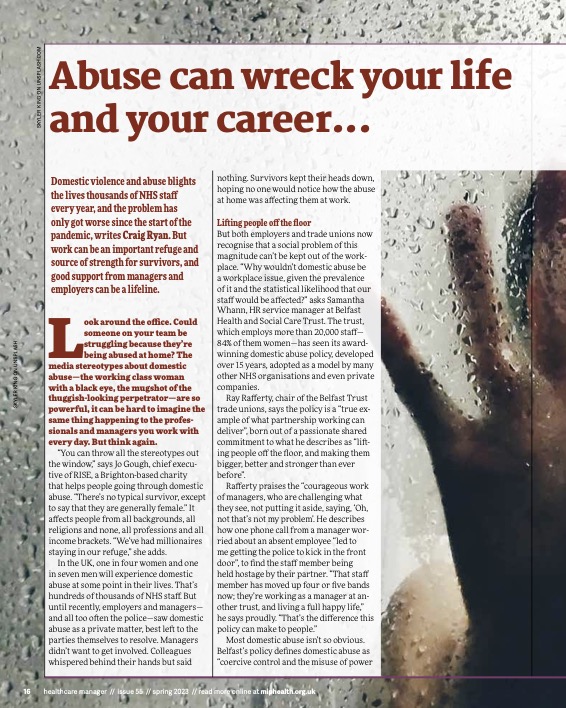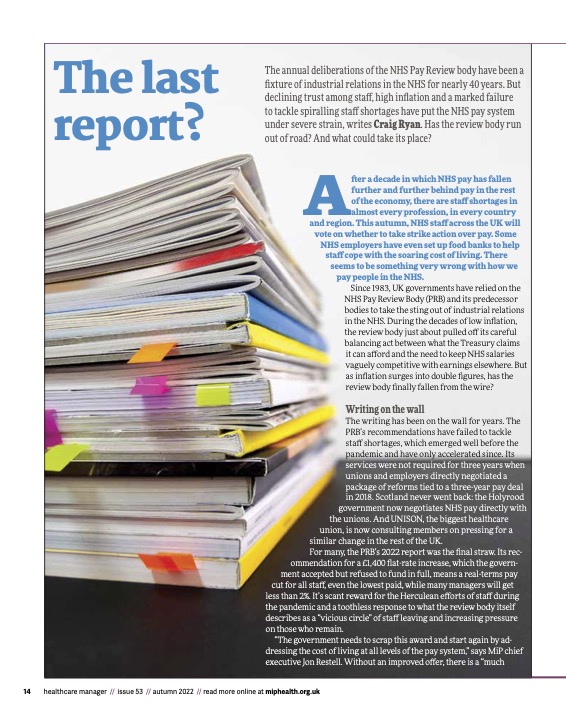Published in Public Service Magazine, Spring 2018.
Last year’s Stevenson-Farmer report set out an ambitious agenda for improving mental health and wellbeing in the civil service. Craig Ryan explores the deep culture changes needed to make sure all civil servants can thrive at work.
In January 1974, at the height of the three-day week crisis, the head of the civil service, Sir William Armstrong, suffered a stress-induced mental breakdown. According to several accounts, Armstrong was found naked on the floor of the Downing Street waiting room, chain smoking and raving about the end of the world. The following morning he convened a meeting of his Permanent Secretary colleagues and harangued them about preparing for Armageddon. Armstrong was admitted to hospital, but was back at work within a few weeks. Three months later, he left the civil service and became chairman of Midland Bank.
Armstrong’s breakdown was hushed up and the lessons ignored. Although colleagues later said the warning signs had been there for years, Armstrong received no support and never talked about his problems. The impact of severe stress and overworking on his ability to advise the Prime Minister at a crucial juncture in Britain’s history was never considered. And the effect on Armstrong’s own health – he died just a few years later – was perhaps greater than he knew.
On the surface, the contrast with today’s civil service couldn’t be greater. Government Chief People Officer Rupert McNeil has spoken openly about his problems with anxiety and encouraged colleagues to do the same. Departments have health and wellbeing champions, and have rolled out a plethora of mental health initiatives in recent years, including mental health first aider training, expanded employee assistance programmes and networks where staff get together to talk about workplace problems and the impact on their mental wellbeing.
When Lord Dennis Stevenson and MIND chief executive Paul Farmer published their independent review of workplace mental health, Thriving at Work, in October last year, the government not only accepted all the recommendations as an employer, but designated the civil service as an ‘early adopter’ of the mental health standards laid down in the report (see box). It was, and was intended to be, a clear signal that the civil service is now taking mental health seriously.
But it still has a lot to get serious about. The Stevenson-Farmer report says the scale of the mental health challenge in Britain’s workplaces is “greater than we thought”, and the civil service is no exception. According to MIND’s Workplace Wellbeing Index, public sector workers experience poorer mental health than those in the private sector, with one in six describing their mental health as “poor” and 53% saying they regularly feel anxious at work. Research by Deloitte’s puts the cost of mental health problems to the government at around £1,500 per civil servant every year – again, higher than the average for private sector employees.
Duncan is a senior manager with a large civil service agency who has suffered from stress-induced anxiety and depression for several years. Two years ago, he was signed off sick after visiting his GP. “I realised quite suddenly that I couldn’t cope, but the problems had been building up for a long time,” he says. “My workload was ridiculous – but so was everyone else’s. There’s this enormous pressure to be busy and to be just about coping, so I just tried deal with it. But I wasn’t sleeping properly, I was drinking a lot and things were starting to fall apart at home.”
Although Duncan’s manager was “not unsympathetic”, Duncan didn’t feel confident discussing his mental health. “I felt I couldn’t cross that threshold, admit I had a real problem. You don’t want to open up that whole can of worms – with capability reviews and assessments by [occupational health]. I was worried about my PMR, my reputation, I was worried about being made redundant – everything really.”
“Working in the civil service is demanding,” says Faye McGuinness, head of workplace wellbeing at MIND, who works with the civil service leadership on implementing the findings of the report. She cites long working hours, regular inspections, lack of interaction with colleagues, and cuts to budgets and staffing as factors that can put pressure on the mental health of all public sector workers.
“The onus should be on employers to support their staff through the difficult times, so they can come to work at their best, and in turn get the best outcomes for the people they represent – which is why implementing the recommendations [of the report] is so important,” says McGuinness.
Work across Whitehall is being lead by Jonathan Jones, the Ministry of Justice Permanent Secretary who is also the civil service health and wellbeing champion, with support from the Civil Service Employment Policy (CSEP) unit in the Cabinet Office and wellbeing champions in each department.
Jones tells PSM that he has “identified strategic priorities to change the culture towards health and wellbeing in the civil service… These include emphasising visible leadership, enabling honest and open conversations about mental health and encouraging an all-round healthy lifestyle.”
Work is already underway in 18 departments to benchmark existing programmes against the standards set in Thriving at Work . The report identified areas of existing good practice and those where collective improvement was needed, Jones explains, “including how we communicate our offer on mental health to employees, how we continue to build line manager skill and confidence, and how we consistently support people with mental health conditions within the recruitment process.”
The newly rebranded Ministry of Housing, Communities and Local Government (MHCLG) is widely recognised in Whitehall for being ahead of the curve on supporting workforce mental health. “When I joined the department in 2016, what really struck me was the openness within the [health and wellbeing] network, but also more broadly to talking about mental health issues,” says Jillian Kay, the ministry’s health and wellbeing champion.
“There were events going on where people were sharing their own lived experiences quite comfortably and openly, and similarly people sharing their own experiences online,” she recalls. “So I sensed that in terms of breaking the stigma it’s certainly a place where lots of people felt safe to share their stories, which felt like a really positive thing.”
In 2015, The department introduced mental health first aid training and a mental health ambassador listening and support service. MHCLG now has 150 trained mental health first aiders and has a thriving health and wellbeing staff network, and last year was it chosen to design and deliver the mental health awareness workshop at Civil Service Live.
Kay emphasises that the engagement of senior managers is crucial to shifting the workplace culture towards improving mental health. “I was a bit surprised to see members of the SCS on the mental health first aid training when I joined, but actually we’ve now trained 12 SCS members,” she says. “More than 40 first aiders have gone on to become mental health ambassadors, and they provide a listening and advice service to people who need it, including line managers who want to support their staff.” The ministry also runs specialised wellbeing workshops for senior leaders, including one recently facilitated by FDA national officer Jane Cockram.
Staff resilience and good mental health is very much a live issue for Kay as a manager. In her ‘day job’, she leads for the department on Grenfell recovery and resilience. “Some of our teams have been working with Kensington and Chelsea Council on support for all those affected by the fire. So I’ve get a set of staff who’ve had to be quite resilient over the last year,” she says.
“It really brings home the point that we’re trying to get across in the civil service that we all have good and bad mental health at different times depending on what we’re experiencing. An important part of this is making sure that mental health isn’t a kind of niche agenda, it’s something that’s relevant to everyone – and it became really relevant to all of us over the last year.”
At the same time, the civil service needs to identify and meet the needs of staff who are at a higher risk of developing mental health problems because of the nature of their work, which may include “mainstream” civil servants like Jillian Kay’s MHCLG staff, as well as more obvious candidates like people working for the security services or the National Crime Agency.
“Departments are being supported centrally to identify teams where there may be a higher risk of stress and trauma, [and] to in turn identify tools and best practice to help all departments address these issues,” explains Jonathan Jones. “Because the support may vary according to the types of work, it’s right that departments lead this work as they’re closer to the detail.”
One of the persistent themes in the Stevenson-Farmer report is the need for employers to move away from the traditional ‘performance management’ approach, where mental health problems – if they were discussed at all – were tackled as issues of individual capability. This lead to a ‘culture of silence’, where employees kept quiet about mental health problems for fear of demotion, reprimand – or worse.
Instead, says McGuinness, employers need “to create a culture where staff feel able to talk openly about stress and mental health, and know that if they do, they’ll be be met with support and understanding rather than stigma and discrimination.”
This also means managers taking some responsibility for the mental wellbeing of their staff, something that is reflected in one of the Stevenson-Farmer’s most striking recommendations: that civil service leaders should have the mental wellbeing of their staff enshrined in their performance objectives.
“It’s important that Permanent Secretaries and Chief Executives lead by example, and consider how they can be held accountable for the wellbeing of their staff,” says McGuinness. “Having performance objectives relating to employee mental health is one way they can do this… Showing staff that employee mental health is a key priority, and one that they are willing to be measured against, is a step towards creating a positive culture where… staff feel able to talk about their mental health problems.”
This would certainly be a unprecedented step, with big potential to drive meaningful change. “It’s difficult for us to talk about how this would be implemented as this is based on how they manage this internally. We don’t yet have any other examples of this being done before,” adds McGuinness.
Since returning to work, Duncan says he has benefited from some adjustments to his workload and from taking part in a staff wellbeing network. “Colleagues have been much more supportive than I expected and [management] have been willing to make some changes, which have definitely helped me,” he says. But he still fears his career has suffered, and doesn’t feel confident about pursuing promotion opportunities in the near future. “I still feel there’s this bit of a stigma hanging over me,” he adds.
Duncan still doubts many of his colleagues would be willing to discuss mental health problems openly with senior managers. “Maybe more managers are willing to have that kind of [supportive] conversation now, but I don’t think it’s enough to change the way people feel,” he says.
Whitehall has come a long way since Sir Robert Armstrong was reduced to rolling around on the Downing Street floor, and mental health problems are being discussed in a way that would have been unthinkable a generation ago. MIND’s Faye McGuinness, who has monthly meetings with civil service leaders to monitor progress, says: “We know there is a long way to go, and that change doesn’t happen overnight. But it’s positive that Government, and in turn, civil service employers, have accepted all the recommendations from the review and see the value in implementing them.”
For Duncan, the big challenge is ending the culture of silence around mental health, and that takes time: “In the end, it’s not about what support programmes there are, but whether people have trust and confidence to use them. I don’t think we’re quite there yet,” he says.
Stevenson-Farmer: key recommendations for the civil service
- Permanent secretaries and agency chief executives to have performance objectives relating to employee mental health
- Commitments to mental health standards to be written into Single Departmental Plans
- Routine monitoring of employee mental health
- Enhanced mental health training for staff at all grades, especially for line managers
- Employers to identify staff and higher risk of stress or trauma and develop a national framework of support
- Tailored in-house mental health support with signposting to clinical support
- Encourage open conversations about mental health and the support available to staff



 The idea of the “providential man” (or woman, in the case of Joan of Arc) who will banish the nation’s woes through sheer force of personality, is deeply embedded in the French psyche, Plowright claims. Quoting the eminent French historian
The idea of the “providential man” (or woman, in the case of Joan of Arc) who will banish the nation’s woes through sheer force of personality, is deeply embedded in the French psyche, Plowright claims. Quoting the eminent French historian  Attlee’s deep sense of patriotism and loyalty is the key to understanding his enduring political achievements. As a “social patriot” his patriotism, “meant not fidelity to caste or cohort, but to the commonwealth”. Attlee himself said his proudest achievement was not the NHS, but taking Labour into the wartime coalition with his friend Winston Churchill.
Attlee’s deep sense of patriotism and loyalty is the key to understanding his enduring political achievements. As a “social patriot” his patriotism, “meant not fidelity to caste or cohort, but to the commonwealth”. Attlee himself said his proudest achievement was not the NHS, but taking Labour into the wartime coalition with his friend Winston Churchill.